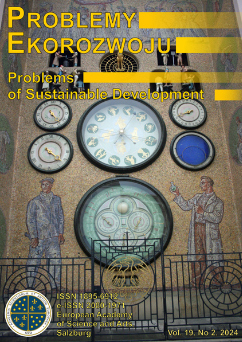Spójność Unii Europejskiej i krajów Bałkanów Zachodnich w kontekście zrównoważonego rozwoju podróży i turystyki
Sonja Jovanović
University of Niš, Faculty of Economics, Niš (Serbia)
https://orcid.org/0000-0003-0937-9195
Vesna Janković-Milić
University of Niš, Faculty of Economics, Niš (Serbia)
https://orcid.org/0000-0002-9645-8598
Marija Petrović-Ranđelović
marija.petrovic@eknfak.ni.ac.rsFaculty of Economics University of Niš, Republic of Serbia (Serbia)
Abstrakt
Zarządzanie przyszłą polityką i strategią rozwoju turystyki staje się coraz większym wyzwaniem ze względu na stale zmieniające się otoczenie. Istotne jest zidentyfikowanie kluczowych wymiarów i wdrożenie koncepcji zrównoważonego rozwoju, aby zapewnić zrównoważony rozwój turystyki. Celem artykułu jest zbadanie wymiarów rozwoju zrównoważonej turystyki w krajach Unii Europejskiej i Bałkanach Zachodnich. Celem jest analiza spójności tych krajów pod względem zrównoważoności rozwoju turystyki i podróży. Celem artykułu jest także określenie poziomu odstawania Bałkanów Zachodnich od krajów Unii Europejskiej pod względem zrównoważenia gospodarczego, ekologicznego i społecznego rozwoju turystyki. Identyfikacja kluczowych elementów zrównoważonego rozwoju turystyki w tych krajach jest ważna dla stworzenia strategicznych wytycznych do zarządzania turystyką oraz kierowania podażą i popytem na dynamicznym rynku turystycznym.
Słowa kluczowe:
turystyka zrównoważona, Indeks rozwoju T&T, kraje europejskie, spójność krajów, klasterBibliografia
BALLANTYNE M., PICKERING C.M., 2013, Tourism and recreation: A common threat to IUCN red-listed vascular plants in Europe, Biodiversity and Conservation, 22: 3027-3044, https://doi.org/10.1007/s10531-013-0569-2
DOI: https://doi.org/10.1007/s10531-013-0569-2
Google Scholar
BUTLER R.W., 1999, Sustainable tourism: a state-of-the-art review, Tourism Geographies, 1(1): 7-25, https://doi.org/ 10.1080/14616689908721291.
DOI: https://doi.org/10.1080/14616689908721291
Google Scholar
CERNAT L., GOURDON J., 2007, Is the concept of sustainable tourism sustainable? Developing the sustainable tour-ism benchmarking tool, United Nations Conference on Trade and Development, New York and Geneva.
Google Scholar
DENSTADLI J. M., JACOBSEN J.K S., 2014, More clouds on the horizon? Polar tourists’ weather tolerances in the context of climate change, Scandinavian Journal of Hospitality and Tourism, 14(1): 80-99, https://doi.org/10.1080/15022250.2014.886096.
DOI: https://doi.org/10.1080/15022250.2014.886096
Google Scholar
Editorial, 2016, Sustainable tourism, progress, challenges and opportunities: An introduction, Journal of Cleaner Produc-tion, 111: 285-294, https://www.researchgate.net/publication/283525759_Sustainable_Tourism_Progress_Challenges_and_Opportunities_Introduction_to_this_Special_Volume (15.05.2023).
DOI: https://doi.org/10.1016/j.jclepro.2015.10.027
Google Scholar
European Commission, UNWTO, UNEP, 2005, Making tourism more sustainable – A guide for policy makers, https://wedocs.unep.org/20.500.11822/8741(15.05.2023).
Google Scholar
GÖSSLING S., BALAS M., MAYER M., SUN Y.-Y., 2023, A review of tourism and climate change mitigation: The scales, scopes, stakeholders and strategies of carbon management, Tourism Management, 95: 104681, https://doi.org/10.1016/j.tourman.2022.104681.
DOI: https://doi.org/10.1016/j.tourman.2022.104681
Google Scholar
HIGGINS-DESBIOLLES F., 2018, Sustainable tourism: sustaining tourism of something more? Tourism Management Perspectives, 25: 157-160, https://doi.org/10.1016/j.tmp.2017.11.017.
DOI: https://doi.org/10.1016/j.tmp.2017.11.017
Google Scholar
KARIMINIA S., AHMAD S.S., HASHIM R., 2012, Assessment of Antarctic tourism waste disposal and management strategies towards a sustainable ecosystem, Procedia-Social and Behavioral Sciences, 68: 723-734, https://doi.org/10.1016/j.sbspro.2012.12.262.
DOI: https://doi.org/10.1016/j.sbspro.2012.12.262
Google Scholar
KO T., 2005, Development of a tourism sustainability assessment procedure: a conceptual approach, Tourism Manage-ment, 26(3): 431–445, https://doi.org/10.1016/j.tourman.2003.12.003.
DOI: https://doi.org/10.1016/j.tourman.2003.12.003
Google Scholar
KOURTIT K., NIJKAMP P., SCHOLTEN H., 2023, Planning for climate–benign cities – Design of a mind map for smart energy transition, Economic Themes, 61(1): 41-61.
DOI: https://doi.org/10.2478/ethemes-2023-0003
Google Scholar
LEE T.H., HSIEH H.-P., 2016, Indicators of sustainable tourism: A case study from a Taiwan’s wetland, Ecological Indicators, 67: 779-787, https://doi.org/10.1016/j.ecolind.2016.03.023.
DOI: https://doi.org/10.1016/j.ecolind.2016.03.023
Google Scholar
LIU Z., 2003, Sustainable tourism development: A critique, Journal of Sustainable Tourism, 11(6): 459- 475, https://strathprints.strath.ac.uk/4105/6/strathprints004105.pdf (15.05.2023).
DOI: https://doi.org/10.1080/09669580308667216
Google Scholar
MILLER G., 2001, The development of indicators for sustainable tourism: Results of a Delphi survey of tourism research-ers, Tourism Management, 22(4): 351-362, https://doi.org/10.1016/S0261-5177(00)00067-4.
DOI: https://doi.org/10.1016/S0261-5177(00)00067-4
Google Scholar
MINISTRY of Tourism and Youth of the Republic of Serbia, 2021, Strategijski marketing plan turizma Republike Srbije do 2025. Godine, https://mto.gov.rs/tekst/177/strategije.php (15.05.2023).
Google Scholar
NEIDZIOLKA I., 2014, Sustainable tourism development, Regional Formation and Development Studies, 3(8): 157-166, https://core.ac.uk/download/pdf/233176826.pdf (15.05.2023).
DOI: https://doi.org/10.15181/rfds.v7i2.2371
Google Scholar
PICKERING C.M., HILL W., 2007, Impacts of recreation and tourism on plant biodiversity and vegetation in protected areas in Australia, Journal of Environmental Management, 85(4): 791-800, https://doi.org/10.1016/j.jenvman.2006. 11.021.
DOI: https://doi.org/10.1016/j.jenvman.2006.11.021
Google Scholar
STANIŠIĆ T., MILIĆEVIĆ S., KRSTIĆ B., 2022, Natural resources in function of sustainable and competitive tourism development of the EU countries, Problemy Ekorozwoju/ Problems of Sustainable Development, 17(1): 64-70, https://doi.org/10.35784/pe.2022.1.06.
DOI: https://doi.org/10.35784/pe.2022.1.06
Google Scholar
VILCASSIM M.J.R., CALLAHAN A.E., ZIEROLD K.M., 2021, Travelling to polluted cities: A systematic review on the harm of air pollution on international travellers’ health, Journal of Travel Medicine, 28(4): 1-13, https://doi.org/10.1093/jtm/taab055.
DOI: https://doi.org/10.1093/jtm/taab055
Google Scholar
WEF, 2007, Travel and tourism competitiveness report 2007: furthering the process of economic growth, Geneva, Swit-zerland, http://tourismlibrary.tat.or.th/medias/WEF0004/WEF0004_fulltext.pdf (15.05.2023).
Google Scholar
WEF, 2021, Travel & tourism development index 2021: rebuilding for a sustainable and resilient future, https://www.weforum.org/reports/travel-and-tourism-development-index-2021/ (15.05.2023).
Google Scholar
WEF, 2022, Ten principles for sustainable destinations: charting a new path forward for travel and tourism, https://www3.weforum.org/docs/WEF_Ten_Principles_for_Sustainable_Destinations_2022.pdf (15.05.2023).
Google Scholar
Autorzy
Sonja JovanovićUniversity of Niš, Faculty of Economics, Niš Serbia
https://orcid.org/0000-0003-0937-9195
Autorzy
Vesna Janković-MilićUniversity of Niš, Faculty of Economics, Niš Serbia
https://orcid.org/0000-0002-9645-8598
Autorzy
Marija Petrović-Ranđelovićmarija.petrovic@eknfak.ni.ac.rs
Faculty of Economics University of Niš, Republic of Serbia Serbia
Statystyki
Abstract views: 135PDF downloads: 333









